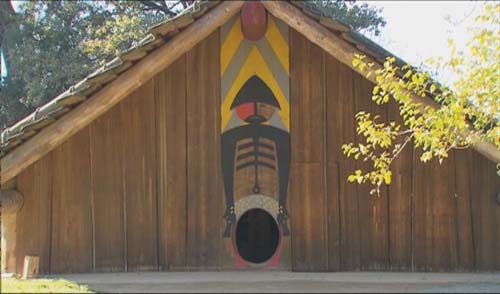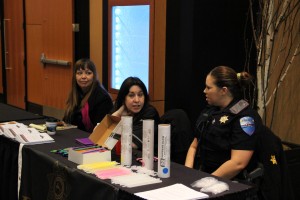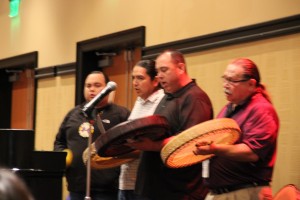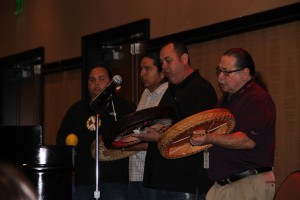Category: Tulalip News
Communicating through melodies

By Brandi N. Montreuil, Tulalip News
TULALIP – Drummer and singer, 24 year-old Tulalip artist Cary Micheal Williams, is among a handful of Native American flute players paving the way in Tulalip for the instrument. As a self-taught flutist he is working on his first music album featuring original melodies. His overall goal is not to become commercialized, but rather to teach the craft and sacredness of the flute to the next generation.
Recently, Tulalip News/See-Yaht-Sub was able to sit down with Williams and discuss his music, teaching, and current music project.
SYS: How long have you been playing the flute?
Williams: I would say a solid seven years. I will be playing for the rest of my life, and teaching it too.
SYS: You are also a drummer so how did you get into playing the flute?
Williams: Yes and I also sing. It first started with me going to my grandpa. He was upstairs in his art room and I said, “I want to play the flute.” He said, one second, and went downstairs. My grandma and grandpa had already bought a flute and he brought it upstairs and gave me that flute. He said, “Your grandma said you better take care of it. It’s a really expensive flute.” Right when he handed me the flute I played a song. Instantly I knew how to play and it was amazing. I went downstairs and played a song for my grandma. The song has changed over time because the flute is different. I was going up a hill after playing on a cliff side and I fell and the flute broke. I recently bought this new flute and it sounds similar to that one.
SYS: How did you choose your flute?
Williams: This flute fits to me naturally. When I was in a prayer ceremony, I kind of felt this change. I was playing my other flute and a different note came out of it as I was playing. Later on down the road I bought this current flute. That connection was just there, so I picked it up. It is made of really high quality; it is yellow cedar, red wood, and turquoise. It has a yellow cedar borough too, so it has a different tone that will come out of it with different melodies.
 SYS: It sounds like the flute is more than just an instrument to you, and there is a sacredness to be being a flutist.
SYS: It sounds like the flute is more than just an instrument to you, and there is a sacredness to be being a flutist.
Williams: Yes, because it is like its own life. I am honored to give the life into it and the melodies come from the birds. Every now and then I will just get a melody flowing through me and I will start playing it. The flute is very versatile, it can send out a message without much interaction. I noticed if you beat a drum, you shake everything up, but if you were to play the flute you would attract way more people, and unity is what we need. That is what I stand behind with my flute, is bringing people together. I’ve always been that guy off to the side playing my flute.
SYS: You mentioned a difference between playing the flute and the drum; how do you go from hitting a drum to controlling your breathing in order to play the flute?
Williams: Singing really helps. It really opens up my diaphragm. My singing diaphragm is way lower so I am allowed to get more air out through the flute to my songs. When I stand up my diaphragm is more open, but also when I sit, I have more control over it. From being a singer from a young age my uncle taught me how to do techniques, he would make me lay on the floor and put books on my stomach and tell me to breath.
SYS: How often do you practice?
Williams: There’s just times where I will get this feeling and I’ll go grab my flute and start playing. I make sure I always have it with me wherever I go, even if I am in the city. If there is someone 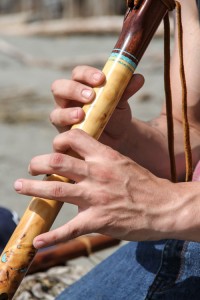 I run into, it’s like, “Hey I want to play you a flute song.” It’s not only healing for them but for me too.
I run into, it’s like, “Hey I want to play you a flute song.” It’s not only healing for them but for me too.
SYS: Do you have a favorite melody so far?
Williams: I think all my songs are my favorite. I remember all my songs from my first flute to the one that I just received. I have this library of songs that run through my head.
SYS: Do you have a name for your album yet?
Williams: I think it would be named Sounds of the Birds, because every time I play I see birds on my flute, just bouncing around and I connect with them. I can hear all the birds singing with me.
SYS: Is there a particular bird that you draw inspiration from?
Williams: There isn’t one particular bird, more like a couple of birds. There is the eagle, woodpecker, blue jay, hummingbird, owl and I can’t forget the water bird. I get a lot of my songs from the birds and from the trees too. My favorite noise is when I tap on my flute keys. I don’t know why, but it is settling. Sometimes I have to play in front of a whole bunch of people and it is my way of grounding myself before I play.
SYS: Do you use sheet music for your songs?
Williams: No, it is all in my head. I have a friend that knows how to transfer the music into the periodic table and is working on putting it onto sheet music.
Some children have it [musical talent] naturally and some children have to learn it a different way. If I can master both the teachings [styles] then I will be able to hand it over. That’s what I am aiming for. I have been working on it for a long time. I didn’t know it would become my personal mission, but the flute is a gift for all people.

SYS: There aren’t a lot of Tulalip flute players; there are mainly drummers and singers. Do you feel like you are helping to create a space for flutists in Tulalip?
Williams: Yes, for future flutists most definitely. My nephews are going to be flutists. I have them blow in the flute and I will push the keys for them. They are literally using their air, so it shows them that their air that is booting through the flute can do it.
SYS: Where do you want to take your music?
Williams: I believe I can take flutist of the year. I just have to keep moving down that road. My main drive is to allow the next generation to pick up the flute, because everyday it is there for me. I think it could be there for our children too, or whoever wants to learn. It is really good medicine for yourself and I found also it is good medicine for others, so I am always willing to share it. I was told that the melodies, harmonic tones and vibrations from the flute have healing power. It can heal wounds and feelings. Don’t limit it.
Cary Micheal Williams from Brandi Montreuil on Vimeo.
Brandi N. Montreuil: 360-913-5402; bmontreuil@tulaliptribes-nsn.gov
Second Appraisal Day at Hibulb a success
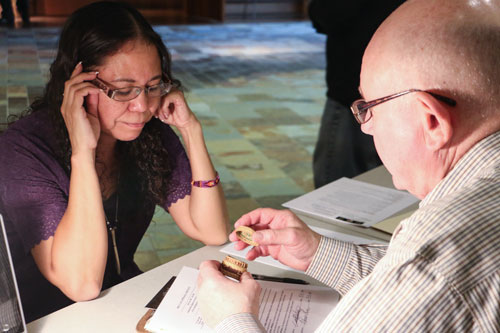
Photo/ Brandi N. Montreuil, Tulalip News
By Brandi N. Montreuil, Tulalip News
TULALIP – It was basket extravaganza at the second Hibulb Appraisal Day on Saturday, May 3, when the center welcomed Brill Lee, an accredited member of the International Society of Appraisers and independent appraiser, for the second time.
Almost a dozen guests attended the event, bringing more than a dozen items to be appraised. Items, unlike the first Hibulb Appraisal Day, were mainly baskets made by local Native American artists and Alaska Native weavers. The baskets displayed a wealth of weaving skill and tribal history.
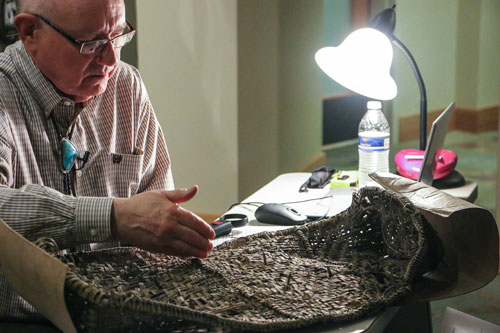
Photo/ Brandi N. Montreuil, Tulalip News
The surprise of the day was a basket-like item rescued from the Nooksack River by a tribal fisherman. The basket featured weaving patterns and material not indigenous to this area and was referred to the Seattle Burke Museum for further study.
The center was gifted a pair of leather beaded gauntlet gloves, donated by guest Troy Jones. The gloves were a trade item in 1930 to a service station in Granite Falls for work completed on a vehicle. The gloves have been in his family since the trade. Lee appraised the item at $3,000 to $3,500 due to the current market value, condition, material used, and artist skill.
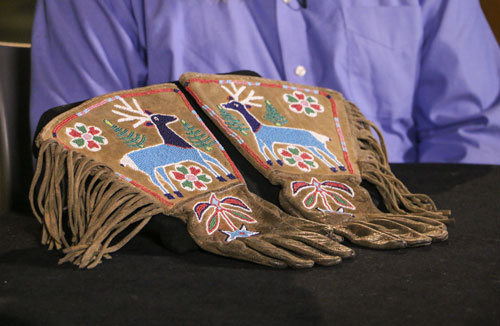
Photo/ Brandi N. Montreuil, Tulalip News
Combined value of items appraised during event totaled more than $8,600.
If you are interested in having an item appraised, you can check out Brill Lee’s website at www.brillleeappraisals.com or by telephone at 425-885-4518. For more information about events happening at Hibulb or the next Hibulb Appraisal Day, please visit their website at www.hibulbculturalcenter.org.
Brandi N. Montreuil:360-913-5402; bmontreuil@tulaliptribes-nsn.gov
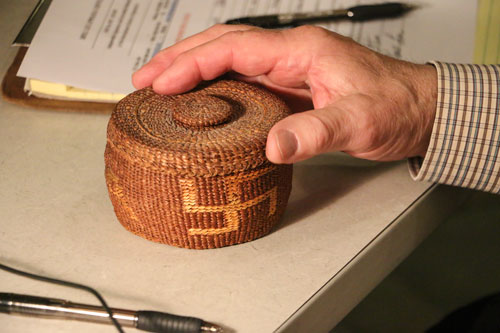
Photo/ Brandi N. Montreuil, Tulalip News
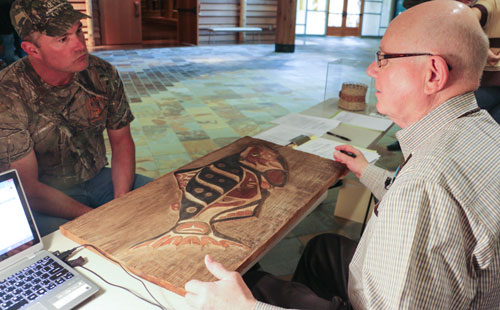
Photo/ Brandi N. Montreuil, Tulalip News
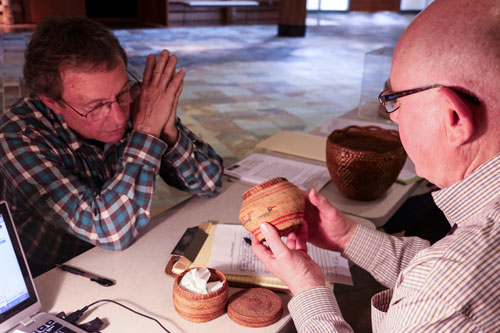
Photo/ Brandi N. Montreuil, Tulalip News
May 7, 2014 syəcəb
The value of saving a life: Proposed law to grant temporary immunity to save lives
By Andrew Gobin, Tulalip News
TULALIP – A proposed new law on the Tulalip Indian Reservation raises the question of the value of life, and in turn the value of saving a life. Called the Lois Luella Jones Law after a victim of overdose, the law would encourage people to seek help from 911 emergency services through temporary immunity, which removes the fear of arrest and or conviction. The intent is to cut down on the number of preventable deaths in the community. There are two drafts of the proposed law with distinct differences, though in each the goal is the same, to encourage people to report emergencies without the fear of self-incrimination.
Rico Jones-Fernandez, who proposed the law for Tulalip, is the son of Lois Luella Jones, for whom the law is so named. He is a strong proponent of 911 Good Samaritan Laws in communities that battle drug addiction.
“This isn’t a law enforcement issue, it’s about saving lives,” he said.
Jones-Fernandez’s draft of the proposed law states that persons seeking medical assistance for a person experiencing an overdose or other life threatening emergent situation are to be granted immunity from arrest and prosecution for minor offenses. In his draft, minor offenses are defined as contributing to the delinquency of an underage person, possession of a controlled substance, possession of drug paraphernalia, and minor in possession. Immunity extends beyond crimes listed to warrants for misdemeanors and nonviolent crimes as well.
“It’s not condoning the crimes and behaviors, it’s saying that a life is more important than a drug charge,” said Jones-Fernandez.
Jones-Fernandez’s draft, as written, has raised question and concern for public safety. Tulalip Prosecutor, Dave Wall, along with reservation attorney, Anthony Jones, also drafted a law that keeps the intent of the law in-tact, while taking into account public safety as a continuing priority. The main difference between the two drafts is the definition of immunity. Jones-Fernandez’s draft explicitly states that the immunity prevents arrest and conviction for crimes listed, whereas the draft written by tribal attorneys reserves the power to arrest yet still extends immunity to convictions for the crimes listed.
Wall said, “The police have a responsibility to public safety, and to keep the peace. They need to retain the power to make arrests.
“Stopping an arrest,” he continued, “that is very hard. Stopping charges or a conviction is much easier. We aren’t rushed to make a decisions like with an arrest. We have time to contemplate circumstances and weigh decisions.”
In addition to concerns surrounding a law enforcement officer’s ability to make arrests, there is a concern regarding warrants. If people are repeat offenders, or have multiple warrants, should those people be eligible for immunity? With regards to misdemeanor warrants and non-violent crime warrants, what defines non-violent crime? Burglary is not a violent crime, yet it is a felony. Should warrants for burglary be overlooked under this law? These are questions the Tulalip Tribal Council will need to answer as they review the two drafts of the proposed law.
“Yes, saving a life is important, but what about the home owner whose property was burglarized. What happens when he learns the police were in extended contact with the burglar, and did nothing, just let him go? What are his rights to justice?” Wall added.
Regardless of the legal and public safety concerns, there is the question of how effective a 911 Good Samaritan Law would be at Tulalip.
“We have nothing to lose. If it is implemented and it is effective, we would be saving that many more lives,” said Jones Fernandez.
Even though both drafts include the provision for immunity from conviction for crimes listed, Jones-Fernandez fears that the tribes’ draft is not protective enough for people seeking medical assistance for overdose victims.
“If it does not protect the caller enough, then the law won’t be effective,” he explained.
Other areas of ambiguity in each draft deal with the terms of immunity, specifically who is eligible for immunity and how long it lasts. If there are ten people at the scene of an incident, but only three were seeking assistance, are all ten granted immunity? It is yet to be clearly defined, though the language of each draft suggests no. The way each draft is worded, immunity is only applicable to those actively seeking medical assistance, or is assisting in some manner. So at a house party, for example, you could not claim to have been unseen in another part of the house and be eligible for immunity. That being said, each draft also puts the burden of discrediting immunity on the prosecution, meaning if someone claims immunity under this law, if it were to pass, the court would have to discredit them, proving beyond a reasonable doubt that this law is not applicable to them.
There is also the question of immunity for people who call repeatedly. As written, neither draft limits how many times you can be granted immunity.
Phino Fernandez, Jones-Fernandez’s brother and fellow supporter of the Lois Luella Jones Law, said, “It can be as repetitious as it needs to be. What makes the 25th life any less important or significant than the first? Why shouldn’t the same value of saving a life apply equally to both?”
It comes back to saving lives. That doesn’t mean people get a free pass, only that the focus has shifted.
“In an emergent situation, we want anyone to feel safe enough to call for assistance to save a life. In terms of the war on drugs, when someone is overdosing, the war has been lost. The battle for that person’s life is now the focus. We can sort out the rest later,” explained Wall.
Both drafts of the law address what happens after the fact. If new crimes and circumstances arise out of the emergent situation, immunity is no longer applicable, and the proposed law would no longer be able to suppress evidence in those cases. That means the temporary immunity ceases after the overdose or emergent situation has concluded, preventing larger crimes that arise from overdose situations to go unchecked.
Wall captured the struggle to balance public safety and the value of saving lives quite eloquently in these few words, “I want us as a community, the tribal court and police included, for the overriding factor of saving lives.”
The law has immense support from the community and from tribal leaders. Aside from concerns to public safety, both drafts of the law express that the value of saving lives is paramount to healing our community, and, for offenders, the value of saving a life is a second chance.
On Thursday, May 22, at 5:30 p.m. at the Tulalip administration building, the CEDAR group will be hosting a community forum on this law. The law is set to be presented to the Tulalip Tribal Council for approval in June.
Andrew Gobin: 360-631-7075; agobin@tulaliptribes-nsn.gov
Billy Frank Jr., the foremost champion for Treaty Indian fishing, dies at 83
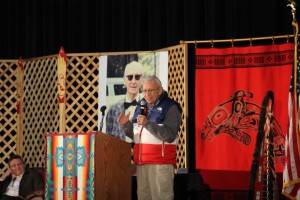
By Andrew Gobin, Tulalip News
In the early hours of May 5, after a lifetime dedicated to protecting treaty rights of northwest tribes, Billy Frank of Nisqually dies at age 83. He is known for championing the battle for Treaty Indian fishing in the 1960s and 1970s, which culminated with the momentous Boldt Decision. He remained ceaseless in his work as chairman at the Northwest Indian Fish Commission (NWIFC) to protect and preserve the salmon resource in all aspects, continuing his work until his final day. The nation mourns the loss of a great man.
In a White House press release, President Barack Obama said this, “I was saddened to learn of the passing of Billy Frank Jr. Today, thanks to his courage and determined effort, our resources are better protected, and more tribes are able to enjoy the rights preserved for them more than a century ago. His passion on the issue of climate change should serve as an inspiration to us all. I extend my deepest sympathies to the Nisqually Indian Tribe, and to Billy’s family, and to his many friends who so greatly admired him.”
Tulalip Tribal Chairman Herman Williams Sr. said, “He’s always been that symbol of our relationship with the state and federal government. He’s the one out in front, leading the fight.”
As serious and determined as he was, Billy was exceedingly humble. He was a man of the people. Wherever he went, he seemed to know everyone, and was always thrilled to see his friends and relatives. He spoke frankly, and was never afraid to speak his mind and say what he knew to be right.
Terry Williams, who worked closely with Frank through the Tulalip Natural Resources Department, said, “Billy had a saying I just loved. He’d say, ‘You have got to tell the truth and recognize the truth.’ That’s what we have faced all our lives.”
Billy Frank spoke from the heart with passion and tenacity. He was revered for his words and what they accomplished.
U.S. Sen. Maria Cantwell, who sits on the Senate Indian Affairs Committee, told the Everett Herald, “Billy Frank was a legend among men. Today, America lost a civil rights leader whose impact will be felt for generations to come.”
His death comes in the middle of a crucial discussion in Washington State that will change the way salmon are protected. The Fish Consumption Rate and the pollution rate are issues to be decided this year. If he were here, his words would be to stay the course. The battle doesn’t stop with the rights, it continues for the survival of the resource.
February 12 of this year marked 40 years since the Boldt Decision. At a celebration at the Squaxin Island resort remembering the battle for Treaty Indian fishing, Frank highlighted how the future of tribes is intertwined with the future of the environment. He said, “We have to protect the salmon. Look at California. The tribes there have the first water right, but there is no water. We have a right to the salmon, but if there are none, what kind of right we got?”
Tulalip Chairman Williams agrees that the fight must continue, but people have to pick up where the old leaders have left off.
“Where will the next Billy Frank rise from?” he said.
Andrew Gobin is a reporter with the See-Yaht-Sub, a publication of the Tulalip Tribes Communications Department.
Email: agobin@tulaliptribes-nsn.gov
Phone: (360) 716.4188
Fire Safety-NBSM Week 1
 By Monica Brown, Tulalip News Writer
By Monica Brown, Tulalip News Writer
Tulalip, WA – May is National Building Safety Month (NBSM) as proclaimed by President Barack Obama in 2013, as a way to “encourage citizens, government agencies, businesses, nonprofits, and other interested groups to join in activities that raise awareness about building safety.” For NBSM, the month of May is broken down into four weeks and the focus put on a new subject for each week, fire safety, disaster safety, backyard safety and green and sustainable building.
The Tulalip Tribes Community Development department is participating in NBSM and would like to make Tulalip residents aware of the hazards in and around the home as well as tips for prevention and safety. Community Development is providing pamphlet information that can be picked up at the Tulalip administration building for the entire month of May, see below for contact information.
The first week of NBSM is designated for fire safety in and around the home, Keeping Fire in its Place. According to the U.S. Fire Administration, each year throughout the U.S., 17,500 people are injured in fires and over 3,400 Americans perish in fires with about 1/3 of those victims being Senior citizens. A few things to consider during fire safety week are to check your smoke alarms, establish an evacuation plan, and purchase a fire extinguisher. It’s also a good time teaching children about fire safety. Annually, children of all ages set over 35,000 fires (U.S. Fire Administration statistic).
Fire Extinguisher information: There are multiple types of extinguishers used for specific flammable materials and what works for one may not work for another. In case of a fire, please do not rely solely on a extinguishing it yourself; call the fire department as soon as you notice the fire and make sure you can get to safety before trying to extinguish it on your own.
· Class A extinguishers put out fires in ordinary combustible materials such as cloth, wood, rubber, paper, and many plastics.
· Class B extinguishers are used on fires involving flammable liquids, such as grease, gasoline, oil, and oil-based paints.
· Class C extinguishers are suitable for use on fires involving appliances, tools, or other equipment that is electrically energized or plugged in.
· Class D extinguishers are designed for use on flammable metals and are often specific for the type of metal in question. These are typically found only in factories working with these metals.
· Class K fire extinguishers are intended for use on fires that involve vegetable oils, animal oils, or fats in cooking appliances. These extinguishers are generally found in commercial kitchens, such as those found in restaurants, cafeterias, and caterers. Class K extinguishers are now finding their way into the residential market for use in the kitchen.
· Multi-purpose fire extinguishers are also made that combine uses such as class “B-C” or “A-B-C” and can be used on two or more of the above type fires.
Some fire districts in Snohomish County offer free smoke alarm installations and fire extinguisher training. Please contact your fire district to schedule a home smoke alarm installation or fire extinguisher training.
Nearby local fire departments:
Tulalip Bay Fire Department Snohomish Co. Fire District 15, 7812 Water Works Rd Tulalip, WA 98271-9631, 360-659-2416
Marysville Fire District, 1094 Cedar Avenue Marysville, WA 98270, 360-363-8500
For pamphlet information about NBSM contact, Orlando Raez, Tulalip Tribes Community Development, 360-716-4214.
10 Important tips to remember for fire safety and awareness
Put a smoke alarm on every level of your home and outside each sleeping area. Put a smoke alarm inside every bedroom.
Make sure your smoke alarms work. Test your smoke alarms. Push the test button. You will hear a loud noise. If you don’t hear the noise, you need a new battery or a new alarm.
Make sure the smoke alarm always has a good battery. Put a new battery in the alarm every year.
Smoke alarms with long-life batteries will work for up to 10 years. You do not change the battery.
Smoke alarms do not last forever. Get new smoke alarms every 10 years.
Tell your family what to do if they hear the smoke alarm. Make an escape plan so everyone knows how to get out fast. Pick a meeting place outside the home where everyone will meet. Some children and older adults cannot hear the smoke alarm when they are sleeping. Make a plan for how to wake them up. Practice your escape plan with everyone in your family two times each year.
Install home fire sprinklers in your home. Home fire sprinklers and working smoke alarms greatly increase your chance of surviving a fire. Sprinklers are affordable and they can increase your property value and lower your insurance rates.
Portable heaters need their space. Keep anything that can burn at least three feet away.
If you live in an area where homes are located in or close to forests or vegetation areas, you should think about the following safety tips.
Install 1/8 inch or smaller mesh screening that cannot burn on attic/soffit vents and around wood decks to keep out embers. Install spark arrestors on fire place chimneys or wood stove vents.
Keep all items that can burn away from your home. Clean leaves from your gutters. Clear dead leaves and branches from shrubs and trees.
Learn about “Spirit of the Ojibwe” on Tulalip TV
By Roger Vater, Tulalip TV
Premiering on Tulalip TV this week is a new episode of Native Report # 808.
Native Report is an entertaining, informative magazine style series that celebrates Native American culture and heritage, listens to tribal elders, and talks to some of the most powerful and influential leaders of Indian country today.
In this edition of Native Report we learn about “Spirit of the Ojibwe,” a special book devoted to the elders of the Lac Courte Oreilles Reservation in Wisconsin. We visit the Chathlopotle Plankhouse, a traditional Chinookan-style cedar structure. And we learn about how the best practices toward revitalizing the Maori Language can also be applied to other language preservation efforts. We also learn something new about Indian country and hear from our elders on this edition of Native Report.
You will be able to watch Native Report Episode – 808 and many other Native programs on Tulalip TV, Channel 99 on Tulalip Broadband or Live on www.TulalipTV.com on a PC, Mac or any ‘Smart’ device such as phone or tablet.
Native Report – 808 can be watched at either of these times: 1:00 p.m. or 9:30p.m.
For a current schedule of Tulalip TV, you can always visit: http://www.tulaliptv.com/tulaliptv-schedule/
Students explore options for life after high school: Opportunity Expo brings employers, colleges, and vocational schools to students
By Andrew Gobin, Tulalip News
The Tulalip Education Department gathered more than 150 representatives from Snohomish County employers, universities, colleges, technical schools, vocational schools, public safety officials, and the military for a comprehensive opportunity exposition on April 22 at the Tulalip Resort Casino. The expo, which filled the entire resort convention area, allowed students and parents to speak with these representatives about their respective fields or entities, allowing the students to explore their options for life after high school.
“There is a time to decide who you want to be in life, what you will do, what type of person you’ll be, and what you want your life to be like. That time is now,” say Ray Fryberg Sr. who spoke when students arrived.
Fryberg, who led a group of Tulalip singers, also sang two songs to welcome students.
Dr. Becky Berg, Superintendent for the Marysville School District, welcomed students to the event, echoing Fryberg and acknowledging the diverse cultures represented in the district.
“Even as you choose a path in life, it is so important to remember your culture as you move forward,” she said.
After the opening remarks, students made their way through a maze of booths where they could stop and talk with employers or recruiters about what they could offer, and what students needed to do to succeed on whichever path they chose.
About 2000 junior and senior high school students from throughout the Marysville School District, and their parents, visited the expo in one of four 90 minute sessions between 8:00 a.m. and 3:30 p.m. The sessions’ limited attendance, allowing students to engage with presenters without the distraction of being crowded. With the ability to move about freely, many presenters brought interactive displays. Chiropractors had skeletal models, engineering firms had working control panels for fire alarm and sprinkler systems, and there was even a vet with a dog and models of canine mandibles.
Some students were looking at colleges and universities, some at vocational schools, and some were more interested in on the job training. Law enforcement, public safety, and military recruiters also added many students to their mailing list for informational packets on entering those fields as well.
“It was a definite success,” said Jeanne Steffner, the Adult Education Financial Aid and Scholarship Specialist for the Tulalip Education Department. “I wish they would do this in other districts. I don’t think students are fully aware of the options open to them. This expo helps them come away with a clear plan for after high school.”
The Tulalip Education Department handed out more than 200 packets to attendees on resources for post-high school education, which is a clear indicator that students wanted to know their options. As more students graduate and move on to higher education or into the workforce, the Marysville School District is closer to success in its mission of 100% graduation, college or career ready.
Andrew Gobin is a reporter with the See-Yaht-Sub, a publication of the Tulalip Tribes Communications Department.
Email: agobin@tulaliptribes-nsn.gov
Phone: (360) 716.4188
Heritage senior sets his sights high

By Andrew Gobin, Tulalip News
After four years with the Tulalip Heritage Hawks, Alan Enick will be graduating. He is one of four seniors that the Hawks will lose this year, after an extraordinary season that ended in upset at the State Championships in March of this year. Alan plans to attend either Northwest Indian College or Everett Community College this fall, and intends to transfer to the University of Washington Bothell.
Alan’s parents, Leon and Annie Enick, have always encouraged him to do well in school and pursue education. After a presentation from the University of Washington Bothell, Alan set his sights on a degree in either business or sports medicine.
He is an excellent student, with his principle Shelly Lacy commending his high attendance record. She said he is always at school, and is always working hard. Alan enjoys art class, particularly beading. He finds it to be relaxing. As a student athlete, he has taken advantage of weightlifting classes and P.E. to better his game. Alan’s parents are very supportive, encouraging him to make good choices. Like every teen, he faces peer pressure to try drugs or to drink underage, though he is proud to say he has never done either. He attributes his strength in overcoming peer pressure to discussions with his father about the importance of good life choices.
Recently, Alan attended a lecture that Tulalip Councilwoman Deborah Parker gave about the Violence Against Women Act, and expounded on some of the issues facing tribes today. Inspired to act from this lecture, Alan is also considering pursuing a degree in Tribal Law.
Andrew Gobin is a reporter with the See-Yaht-Sub, a publication of the Tulalip Tribes Communications Department.
Email: agobin@tulaliptribes-nsn.gov
Phone: (360) 716.4188








